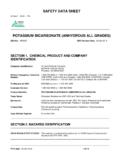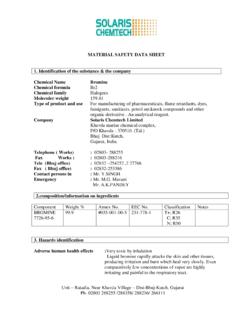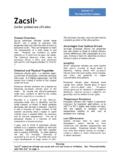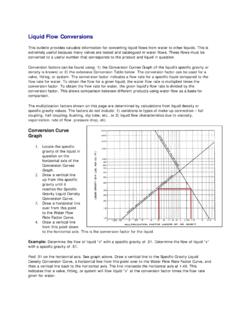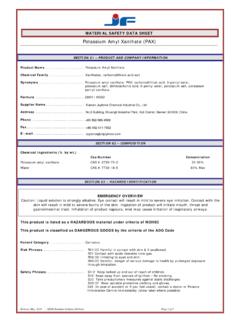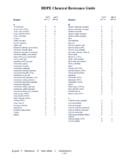Transcription of Safety Data Sheet: Liquid Potassium (Anhydrous All …
1 Potassium CARBONATE (ANHYDROUS ALL GRADES). SDS No.: M1252. SDS Revision Date: 10-Sep-2015 Page: 1M1252 - ANSI - ENPrint date: 10-Sep-20151. CHEMICAL PRODUCT AND COMPANY IDENTIFICATION Company Identification: Armand Products Company 469 North Harrison Street, Princeton, NJ 08543-529724 Hour Emergency 1 800 733 3665 or 1 972 404 3228 (USA); CHEMTREC Telephone Number: (within USA and Canada): 1 800 424 9300; CHEMTREC (outside USA and Canada): +1 703 527 3887; CHEMTREC Contract No: CCN16186To Request an SDS: or 1 972 404 3245 Customer Service: 1 800 522 0540 or 1 609 683 5900 Product Identifier: Potassium CARBONATE (ANHYDROUS ALL GRADES)Trade Name: Potassium Carbonate Extra Fine; Potassium Carbonate Glass.
2 Potassium Carbonate Dense Granular; Potassium Carbonate FineSynonyms: Pearlash, Potash, PotCarbProduct Use: Glass Production, Photographic, detergents / soaps, Fertilizer *, Rubber products, Pharmaceuticals, Potassium Silicates, Food processing, Gas Treatment, Agricultural Chemicals, Cement, catalystsUses Advised Against: None : *Check with national and local regulatory agencies to determine status of use in a fertilizer Products Company469 North Harrison Street, Princeton, NJ 08543-5297 Phone: 800 522 0540. Fax: 800 335 8861 Technical ServicePhone: 716 278 7071. Fax: 716 278 7297 Safety Data Sheet: Liquid Potassium (Anhydrous All Grades)SDS No.
3 : M1252 SDS Revision Date: 10-Sep-20152. HAZARDS IDENTIFICATIONOSHA REGULATORY STATUS: This material is considered hazardous by the OSHA Hazard Communication Standard (29 CFR ).EMERGENCY OVERVIEW: Color: WhitePhysical State: Solid Appearance: Free-flowing, Granular powderOdor: OdorlessSignal Word: WARNINGPage: 2M1252 - ANSI - ENPOTASSIUM CARBONATE (ANHYDROUS ALL GRADES). SDS No.: M1252. SDS Revision Date: 10-Sep-2015 Print date: 10-Sep-2015 MAJOR HEALTH HAZARDS: CAUSES SERIOUS EYE IRRITATION. CAUSES SKIN IRRITATION. MAY CAUSE RESPIRATORY TRACT IRRITATION.
4 HARMFUL IF INHALED OR TOXICITY: HARMFUL TO AQUATIC LIFE. May increase pH of waterways and adversely affect aquatic STATEMENTS: Avoid contact with skin and eyes. Wash skin and contaminated clothing thoroughly after handling. Wear protective gloves, protective clothing, eye, and face protection. Avoid breathing dust. Use only outdoors or in a well-ventilated area. Avoid release to the : CONTACT HAZARD - SKIN Category 2 - Causes skin : CONTACT HAZARD - EYE Category 2A - Causes serious eye : SENSITIZATION HAZARD Not classified as a dermal sensitizer according to GHS criteria. This material when applied to the skin of guinea pigs did not elicit any dermal sensitization : ACUTE TOXICITY - INHALATIONC ategory 4 - Harmful if : ACUTE TOXICITY - ORALC ategory 4 - Harmful if : ACUTE TOXICITY - DERMALNot classified as acutely toxic for dermal : TARGET ORGAN TOXICITY (SINGLE EXPOSURE)Category 3 - May cause respiratory tract : CARCINOGENICITYThis product is not classified as a carcinogen by NTP, IARC or : HAZARDOUS TO AQUATICENVIRONMENT - ACUTE HAZARDC ategory 3 - Harmful to aquatic CLASSIFICATION:UNKNOWN ACUTE TOXICITY: Not applicable.
5 100% of this product consists of ingredient(s) of known acute SYMBOL: Exclamation markPage: 3M1252 - ANSI - ENPOTASSIUM CARBONATE (ANHYDROUS ALL GRADES). SDS No.: M1252. SDS Revision Date: 10-Sep-2015 Print date: 10-Sep-2015 GHS SIGNAL WORD: WARNINGGHS HAZARD STATEMENTS:GHS - Health Hazard Statement(s)Causes serious eye irritationCauses skin irritation Harmful if swallowedHarmful if inhaledMay cause respiratory irritationGHS - Environmental Hazard Statement(s)Harmful to aquatic lifeGHS - Precautionary Statement(s) - PreventionWear protective gloves, protective clothing, eye, and face protectionWash thoroughly after handlingAvoid breathing dustUse only outdoors or in a well-ventilated areaDo not eat, drink or smoke when using this productAvoid release to the environmentGHS - Precautionary Statement(s) - ResponseIF IN EYES.
6 Rinse cautiously with water for several minutes. Remove contact lenses, if present and easy to rinsingIf eye irritation persists: Get medical advice/attentionSpecific treatment (see First Aid information on product label and/or Section 4 of the SDS)IF ON SKIN: Wash with plenty of waterIf skin irritation occurs: Get medical advice/attentionTake off contaminated clothing and wash it before reuseIF INHALED: Remove person to fresh air and keep comfortable for breathingCall a POISON CENTER or doctor/physician if you feel unwellIF SWALLOWED: Call a POISON CENTER or doctor/physician if you feel unwellRinse mouthGHS - Precautionary Statement(s) - StorageStore in a well-ventilated place.
7 Keep container tightly closedStore locked upGHS - Precautionary Statement(s) - DisposalDispose of contents and container in accordance with applicable local, regional, national, and/or international regulations. Hazards Not Otherwise Classified (HNOC)None KnownSee Section 11: TOXICOLOGICAL INFORMATIONPage: 4M1252 - ANSI - ENPOTASSIUM CARBONATE (ANHYDROUS ALL GRADES). SDS No.: M1252. SDS Revision Date: 10-Sep-2015 Print date: 10-Sep-20153. COMPOSITION/INFORMATION ON INGREDIENTSS ynonyms: Pearlash, Potash, PotCarbContains Potassium Carbonate Component Percent [%] CAS NumberPotassium Carbonate 584-08-7 Water 0-1 7732-18-5 Impurities NOT ASSIGNED4.
8 FIRST AID MEASURESINHALATION: If inhaled and adverse effects occur, remove victim to fresh air and keep at rest in a position comfortable for breathing. Call a POISON CENTER or doctor/physician if you feel CONTACT: Immediately brush off excess chemical and flush contaminated areas with plenty of water. Remove contaminated clothing, jewelry and shoes. SPECIFIC TREATMENT: Irrigation with water. IF SKIN IRRITATION OCCURS: GET MEDICAL ADVICE/ATTENTION. Wash contaminated clothing before CONTACT: Immediately flush contaminated eyes with a directed stream of water for as long as contact lenses, if present and easy to do.
9 Continue rinsing. GET MEDICAL ATTENTION : If swallowed: Rinse mouth. Do NOT induce vomiting. Give water as tolerated. Never give anything by mouth to an unconscious or convulsive person. If vomiting occurs spontaneously, keep airway clear. If you feel unwell, contact a poison center or Important Symptoms/Effects (Acute and Delayed):Acute Symptoms/Effects: Listed below. Inhalation (Breathing): Respiratory Irritation: Upper airway irritation, may cause cough, redness of mouth and upper : Skin Irritation: Exposure to skin may cause redness, or irritation. Eye: Eye Irritation: Exposure to eyes may cause severe irritation and redness to the eye lids, conjunctiva.
10 There is potential for permanent and severe eye damage if not treated immediately. Ingestion (Swallowing): Gastrointestinal System Effects: Slightly toxic on ingestion. May be severely irritating to gastrointestinal tract possibly causing oral, esophageal, glottis redness, irritation, ulceration, edema, and stomach and intestinal irritation and burns. Ingestion of large quantities may cause ulceration, vomiting, shock, and Symptoms/Effects: Repeated or prolonged contact may result in dermatitisInteraction with Other Chemicals Which Enhance Toxicity: None Conditions Aggravated by Exposure: May aggravate preexisting conditions, such as: eye disorders that decrease tear production or have reduced integrity of the eye; skin disorders that compromise the integrity of the of First-Aiders: Avoid contact with skin and eyes.

